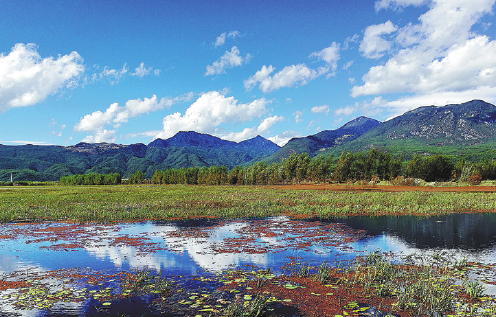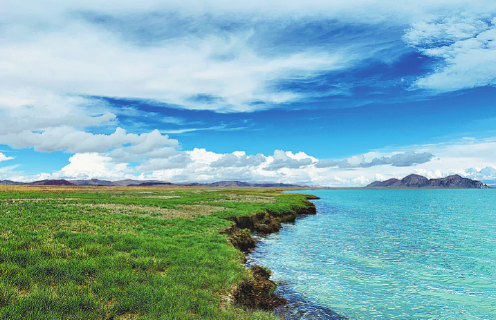Restoration projects boost wildlife protection
China has taken diverse action to tackle global challenges such as shrinking wetlands and the degradation of their ecological functions since its accession to the Convention on Wetlands in 1992.
The country has experienced three stages of wetland protection over the past three decades — baseline inventory and foundation consolidation from 1992 to 2003; rescue protection of wetlands from 2004 to 2015; and comprehensive protection from 2016 to 2021.
The Convention on Wetlands is an intergovernmental agreement that provides the framework for national action and international cooperation for the conservation and use of wetlands and their resources. It had 172 contracting parties by the end of 2021.
This year marks the 30th anniversary of China's accession to the treaty, and the ecological situation of wetlands in the country has been continuously improved. According to the white paper titled the Ecological Condition of China's Wetlands of International Importance (Ramsar Sites), the overall ecological situation of these wetlands has remained stable, and their water quality and biodiversity have been further improved.
In 2003, the State Council issued the Plan for National Wetland Protection Project (2002-30). The central government has so far invested 19.8 billion yuan ($2.75 billion) in more than 4,100 projects for wetland ecological protection and restoration, and carried out these projects together with local governments. Last year, for example, some 3,188 hectares of degraded wetlands were restored, benefiting 16,760 rural households. By 2025, the country's wetland conservation rate is expected to increase to 55 percent.
Also, China's achievements in such fields as wetland protection legislation, the protection of small and micro wetlands, international wetland city certification standards and procedures, and the construction of wetland parks have all played a significant role in the international community, said Zhang Mingxiang, vice-dean of the School of Ecology and Nature Conservation at Beijing Forestry University.
China is the first country in the world to complete three wetland resources surveys nationwide, and the third national land survey, which was conducted from 2017 to 2019, classified wetlands as the first-level land category enjoying special investigation.
In addition, relevant research institutions and local governments have established wetland investigation and monitoring stations, and real-time monitoring and information management platforms.
These stations and platforms are being included in the national forest and grass ecological network system and databases, in a bid to realize the integration of monitoring and supervision.
Statistics show that China has designated 64 Wetlands of International Importance — 63 on the Chinese mainland and one in Hong Kong. The 63 wetlands on the mainland are distributed in 23 provinces, autonomous regions and municipalities.
By 2025, the number of China's Wetlands of International Importance is projected to rise by another 20, and the list of wetlands of national importance is expected to expand by 50, according to the National Forestry and Grassland Administration. The goal for 2030 is to make significant improvement in wetland ecosystem functions and biodiversity, with enhanced integrated services and carbon sequestration capacity. China by then aims to become "a key participant, contributor and leader in global wetland conservation and restoration", the NFGA said.
Xianghai National Nature Reserve in Tongyu county, Northeast China's Jilin province, was one of the first wetlands included in the list of China's Wetlands of International Importance in 1992.
The reserve, established in 1981, mainly aims to protect rare waterfowl such as red-crowned cranes and rare plants. It is also an important wetland for migratory birds to reproduce and refresh themselves during their journeys.
It spreads across more than 100,000 hectares and covers 12 villages in Tongyu, featuring rich biodiversity such as 595 species of wild plants and 316 species of birds.
George Archibald, a founder of the International Crane Foundation, said he has visited nature reserves in more than 50 countries and regions, and Xianghai is one of the few wetlands in the world with perfect natural landscapes, an original ecological environment and diverse wetland organisms.
Qinghai Lake Bird Island Wetland is another Wetland of International Importance listed in 1992. As an important stopover for migratory birds, the wetland is witness to hundreds of thousands of birds each year. It is also the breeding ground for summer migrants. There are 227 species of birds in Qinghai Lake, including 50 species on the list of the China-Japan Agreement on the Protection of Migratory Birds, and 24 species included in the agreement signed by China and Australia to protect migratory birds and their habitats. In 2021, the water area of Qinghai Lake reached 4,625.6 square kilometers, an increase of 375.35 sq km compared with 2005.
Bila River Wetland in North China's Inner Mongolia autonomous region was listed as a Wetland of International Importance in February 2020. Covering a total area of nearly 20,000 hectares, the wetland has diversified landscapes including forest, shrubs, grassland, meadows and swamp, providing a good habitat environment for 1,118 species of wild plants and 691 species of wild animals.
haonan@chinadaily.com.cn














